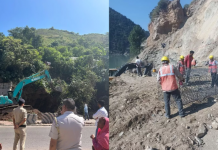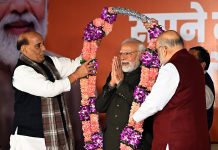 Iran is on the boil with a large majority of its people having expressed their dissatisfaction with the policies of the present ruling dispensation. Iranians mostly live in urban areas (the country’s rural segment accounts for only 27 per cent of its total population, according to the 2015 official statistics) which witnessed large-scale demonstrations in late December, 2017 and the first week of January, 2018 by people frustrated because of an increasing army of the unemployed (over 13 per cent), the rising cost of living (with the inflation rate recorded at 9.7 per cent), a ban on social media and very little political freedom.
Iran is on the boil with a large majority of its people having expressed their dissatisfaction with the policies of the present ruling dispensation. Iranians mostly live in urban areas (the country’s rural segment accounts for only 27 per cent of its total population, according to the 2015 official statistics) which witnessed large-scale demonstrations in late December, 2017 and the first week of January, 2018 by people frustrated because of an increasing army of the unemployed (over 13 per cent), the rising cost of living (with the inflation rate recorded at 9.7 per cent), a ban on social media and very little political freedom.
The Iranian economy is still dependent on its oil and gas reserves, and foreign direct investment is too little to help generate enough employment opportunities. In this 17th largest populated country in the world, people appear to have lost all hopes of economic revival owing to the lop-sided policies of a regime obsessed with acquiring nuclear weapons targeted at dominating the Arab-Gulf states. The government has so far been successful in suppressing people’s desires by using the Islamic Revolutionary Guards Corps (IRGC) enjoying overbearing powers, but now it has been served a notice: there is a limit to this dictatorial practice.
The regime’s repressive policies can no longer help it remain afloat. People’s difficulties on every front will have to be accorded top priority to ensure peace and stability in the country and the region.
The Iranian economy had started breathing in a normal manner with the lifting of the economic sanctions, imposed on it owing to its controversial nuclear energy programme, following the signing of the 2015 nuclear deal with six major powers — the US, the UK, France, Germany, Russia and China. The situation, however, may be back to square one with the Donald Trump administration all set to pull out of the historic agreement, alleging that the Iranian government has been violating the terms of the nuclear deal aimed at preventing Teheran from acquiring nuclear weapons.
The US is little bothered about the EU’s assertion that there have been “no violations” and that there is no scope for renegotiations on the issue. The Trump administration is guided by its strong dislike for anything that had too much involvement of the previous Democratic President Barack Obama.
Here it must be pointed out that any step by the US to destabilise Iran may lead to far-reaching consequences affecting West Asia, South Asia and many other regions. It will not only complicate the situation in West Asia but also push it further towards China and Russia as is the case with Pakistan. India, in particular, will be faced with new challenges to protect its interests in Iran, Afghanistan and Central Asian republics. Under the prevailing circumstances when the gulf of distrust between the US and Pakistan is growing with every passing day, the super power is showing increased interest in India though with a view to primarily protect its own interests in South Asia and the surrounding areas. In any case, India too is bound to be a gainer in such a scenario.
But India’s gain in terms of its close proximity to the US will be at the cost of New Delhi suffering strategic and economic losses in Iran, Afghanistan and Central Asia. India cannot afford to make any move to please the US at the cost of its relations with Teheran, which has provided New Delhi a very dependable route through Iran’s Chabahar port to take its assistance supplies to Afghanistan as well as increase its trade volumes with the Central Asian republics. Islamabad has been told indirectly that New Delhi’s interests in Afghanistan and Central Asian republics cannot be jeopardised by denying India access to Afghanistan by the land route passing through Pakistan.
India-Iran relations got strengthened when they reached an agreement under which India got a 10-year lease to equip and operate two berths in Chabahar Port Phase-I with an investment of USD 85.21 million and an annual revenue expenditure of USD 22.95 million. Chabahar is seen as a counter to Pakistan’s Gwadar port, located at a distance of just 80 km and built with Chinese assistance.
Before the India-Iran Chabahar pact became operational, a trilateral agreement was signed between India, Iran and Afghanistan for a transit and transport corridor using Chabahar as one of the regional trading hubs. India’s insistence on going ahead with its pledge made to Iran may anger the Americans if the US-Iran relations are back to where they were before the nuclear deal with Teheran was signed in 2015. How India handles the new situation will be a very tricky task,.
Another major challenge India may face will be related to the proposed Iran-Pakistan-India (IPI) gas pipeline for cheap availability of Iranian gas. India had kept itself away from the ambitious project with the imposition of US sanctions on Iran, but New Delhi began to show interest in it again after 2015, which will be difficult to sustain if the atmosphere of US-Iran confrontation re-emerges as a result of the Trump administration’s negative policy initiatives.
India opted for an alternative Turkmenistan-Afghanistan-Pakistan-India (TAPI) gas pipeline project being laid with the US backing, but gas available through this source will not be as cheap as it would be from the IPI scheme. Keeping in view India’s own interests, it must continue its efforts for the supply of Iranian gas too. After all, the energy-hungry Indian industry will be only too happy to have an adequate supply of gas at reasonable rates at its doorsteps. The payment problem earlier faced by Iran, which resulted in Teheran suffering a heavy loss of business, is unlikely to be there again as the US under President Trump is not what it was during the days of President Obama.
In any case, Iran will have to first keep its own house in order by taking care of people’s grievances. Finding an excuse in the argument that the Iranian crisis has been caused by enemies of Teheran with a view to settle their old scores will not do. The Iranian rulers divided in two camps — one led by the supreme leader Ayatollah Sayyid Ali Khamenei and the other by elected President Hassan Rouhani — will have to resolve their differences over the issue of overall reforms so that Iran is able to function normally and honour its international commitments. The Iranian clergy, which has enormous constitutional powers, must listen seriously to what President Rouhani says as he is an elected leader and must be knowing about the pulse of the people.
Rouhani, who favours lifting of the curbs on social media, has been quoted to have said, “It would be a misrepresentation (of events) and also an insult to Iranian people to say that they only had economic demands … People had economic, political and social demands.”
Rouhani stands for people being allowed the freedom to criticise their rulers, as is the norm in any conventional democratic set-up. In his opinion, “No one is innocent” or beyond criticism. Now is the time for the Iranian clergy to have a dispassionate look at what the Iranian President has been asserting but without success.
letters@tehelka.com











